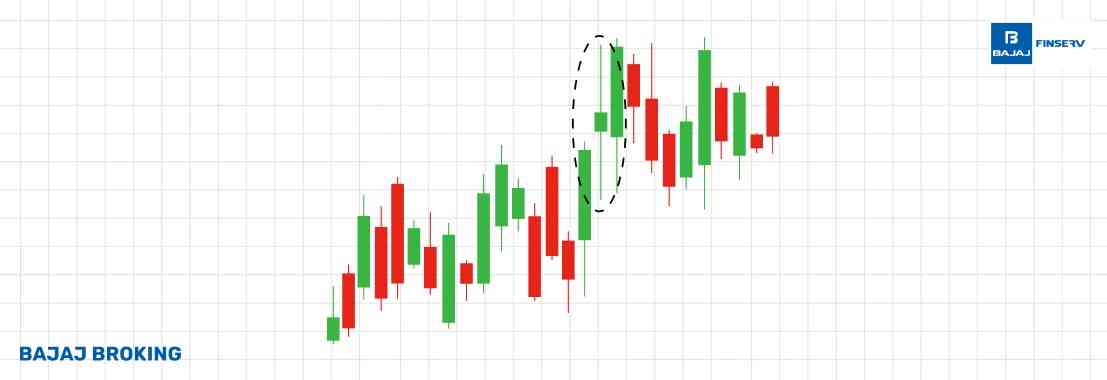Within technical analysis, the spinning top candlestick pattern is a very strong indicator that signals market indecision. A spinning top is identified by a small real body in the middle of long upper and lower shadows, meaning buyers and sellers have not yet taken control. Having a spinning top indicates a time of consolidation and reversal, thus a very good tool for traders to gauge market mood.
What Is a Spinning Top Candlestick?
A spinning top candlestick is a short-bodied candlestick that is surrounded by upper and lower shadows of almost equal length. The short body indicates opening and closing prices were nearly the same, but the long shadows indicate a great price movement within the session.
The pattern indicates a sense of a tug of war between buyers and sellers that ended in a draw at the close of the session. The color of the candlestick—a bull candle, usually white or green, or a bear candle, usually black or red—has little significance in this pattern; attention is more focused on the balance between advancing and declining prices.
What Does the Spinning Top Candlestick Represent?
Spinning top pattern is a visual indication of uncertainty and indecision in the market. It happens when the supply and demand forces are nearly equal, resulting in price fluctuations in a small range before ultimately closing near its initial price level. This state of equilibrium is a sign of a weakening prevailing trend, which means that a reversal or continuation is imminent.
Traders consider the occurrence of a spinning top as a sign to closely observe the subsequent market action, as it can be a sign of the imminent arrival of a significant reversal in price direction. However, if the pattern mildly leans toward the bearish side of the market, for example, it can be considered a bearish spinning top candlestick pattern, and vice versa. But even in such cases the leaning of the trend will be subtle and not very clear.
Additional Read: Technical Analysis Guide
Spinning Top Candlestick Example
Suppose that we have a stock which has been in a long uptrend, with a series of consecutive highs, on a day of trading. It opens at ₹150, reaches a high of ₹160, before falling to a low of ₹145, and then ultimately closing at ₹151. Such a price action results in the creation of a spinning top candlestick, where the narrow range between the opening and the closing price, and the long shadows pointing in the direction of the day's high and low prices.
Formation of this pattern following a prolonged uptrend is a sign that the buying pressure is losing steam, and the sellers are gaining control of the market. Traders who recognize this pattern can get positioned in a favorable position for a probable reversal of the trend, if the subsequent candlesticks indicate a bearish momentum.
How Traders Interpret the Spinning Top Candlestick Pattern
Spinning top patterns are also read by the traders in correlation with broader market patterns and technical indicators. A spinning top on an uptrend may be a sign of weakening of the trend, and the trader may be inclined to cover or tighten stop-loss points. A spinning top on a downtrend may be a sign of weakening of the selling pressure, and the potential for a probable bullish reversal in the future.
However, it is not advisable to trade the spinning top pattern alone; some confirmation in the shape of follow-up price action and confluence indicators such as moving averages or the relative strength index (RSI) should be utilized to confirm any likely change of trend.
Indication of Market Uncertainty
The spinning top candlestick pattern serves as a visual representation of market indecision. Its formation indicates that neither bulls nor bears have dominated the trading session, leading to a balance in buying and selling pressures. This equilibrium can arise from various factors, including:
Economic Data Releases: There could be awaited news reports that keep the traders and investors waiting before making a decision. And such upcoming reports and their impact could go either ways, which influences the market to stay balanced instead of leaning towards either bullish or bearish attitude.
Geopolitical Events: In case of unstable political conditions globally, or even locally, the market could try to stay safe rather than pick either bullish or bearish outlook on the trends. Elections, political controversies, wars, and economic conflicts could influence such indecisiveness in the market.
Earnings Announcements: A stalling effect in investment decisions could also be influenced by companies announcing their earnings reports. Wait for such press releases and the analysis time taken to assess them can often create a pause in the market’s movement towards one side.
Recognizing the spinning top pattern allows traders to identify periods of consolidation and potential turning points in the market, enabling more informed decision-making.
Additional Read: What Is a Candlestick Pattern?
Key Differences Between Spinning Top and Doji
Although both doji candlestick and spinning top patterns indicate indecision, they are different in structure and meaning. A doji is when the opening and closing prices are almost the same, and the very small or nonexistent real body is formed, with shadows of any length. The doji indicates an exact balance between selling and buying pressures.
A spinning top, on the other hand, has a small but perceptible real body, with upper and lower shadows of equal length, indicating that prices moved a lot in the session but closed close to the opening price. The spinning top indicates indecision with greater price volatility than the doji. Knowing these differences enables traders to better interpret market sentiment and accordingly modify their strategy.
Pros and Cons of Spinning Top Candlestick Pattern
The spinning top candlestick pattern is a useful technical analysis tool that signals potential trend reversals and highlights market indecision. It is found in a broad array of markets, including stocks, forex, and commodities, making it a very effective indicator as far as versatility is concerned.
The pattern, however, has its drawbacks. It requires verification from other technical indicators, since using it alone can result in false signals. Second, the frequency of appearance can reduce its reliability, and it is not a good forecaster of the strength of ensuing price movements.
The spinning top pattern is a useful tool, but it must be used alongside other technical tools to realize the highest level of accuracy in decision-making.
Pros
| Cons
|
Signals possible trend changes when appearing after strong price movements.
| Needs validation from other technical indicators to avoid false signals.
|
Alerts traders to uncertainty, allowing for cautious decision-making.
| Frequent appearances may lead to misleading signals without proper analysis.
|
Works in stocks, forex, commodities, and cryptocurrencies.
| Does not indicate the magnitude of a price move, only uncertainty.
|
Helps identify periods of pause before a major breakout.
| Should be used with other patterns and trend analysis for reliability.
|
Traders should weigh these factors and incorporate additional analysis to enhance the reliability of signals derived from spinning top patterns.
Conclusion
The spinning top candlestick pattern is a valuable technical analysis tool, offering a window into market indecision and potential trend reversals. Through the recognition of the pattern and understanding its importance in the overall market context, traders are better equipped to make informed trading decisions.
However, it is wise to use the spinning top in conjunction with other technical tools and analysis methods to confirm signals and develop a full trading strategy. An understanding of the pattern's limitations and the value of confirmation can help traders better navigate the complexities of financial markets with greater success.
Do you have a trading account app or demat account app?
You can open an account with Bajaj Broking in minutes.
Download the Bajaj Broking app now from Play Store or App Store.
Disclaimer: Investments in the securities market are subject to market risk, read all related documents carefully before investing.
This content is for educational purposes only. Securities quoted are exemplary and not recommendatory.
For All Disclaimers Click Here: https://www.bajajbroking.in/disclaimer













